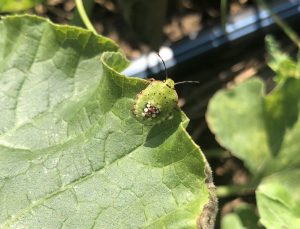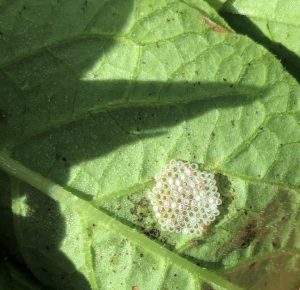The ag sector thrives throughout Suwannee County and for producers to continue to be successful, they require up-to-date information on new emerging crops. One research project being conducted at the NFREC-SV is examining Calabaza Squash as a new emerging crop for north Florida led by Dr. Geoffrey Meru, a UF/IFAS vegetable geneticist. When scouting the field last week, a population of Southern Green Stink Bugs were found.
What are Southern Green Stink Bugs?

Southern Green Stink Bugs are a major pest found in many seed, fruit, vegetable, and nut crops, that originated in Ethiopia. Southern Green Stink Bugs are are now distributed throughout tropical and subtropical regions, such as Florida. This stink bug completes its life cycle in 65-70 days. During the winter months, the adult will reside in tree bark or leaf litter for protection, but will emerge during spring to begin feeding and laying eggs. Females will lay egg masses averaging 30-130 white/yellowish colored eggs on the underside of leaves that will hatch after 5 days. The stink bug will go through four instars, lasting 7 days, and a fifth instar, lasting 8 days, till their final molt to an adult.
Identification:

Stink bug adults are identified by their shield-like body shape, five-segmented antennae, and their horrible smell. The adult is a dull green color with dark red or black eyes. Small dots are along the sides of the abdomen and their wings completely cover the abdomen. Males are ~12mm in length and females ~13mm in length. Nymphs are light yellowish in color with red eyes with transparent legs and antennae. The second instar has black legs, head, thorax, and antennae with a red abdomen and yellow spots along the thorax. During the third and fourth instar, the stink bug increases in size and becomes more greenish in color. Wing pads mark the arrival of the fifth instar, where the abdomen becomes yellowish green with red spots.
Crop Damage:
Stink bugs feed on a variety of plants, but young leaves and developing fruit are ideal. They use their long, straw-like piercing/sucking mouthparts to suck fluids from plant parts causing tissue to become blemished or withered. Damage on fruit from stink bugs can lead to hard brownish or black spots on the skin affecting taste and marketability. In addition, young fruit when damaged, can stunt or die.
Cultural Controls:
- Utilize an integrated pest management plan
- Eliminate host plants in or near crop (weeds)
- Natural enemies – wasps and parasitic flies
- Plant a trap crop – leguminous plants in summer and brassica plants in fall/early spring
Chemical Controls:
Insecticides can be utilized to manage the Southern Green Stink Bug and are commonly applied at blossom and fruit formation. Check out the UF Southern Green Stink Bug askIFAS Website for proper management practices. THE LABEL IS THE LAW. If you have concerns of Stink Bugs in your crop, feel free to call me at the UF/IFAS Suwannee County Extension Office, an Equal Opportunity Institution, for control recommendations at 386-362-2771.
 0
0
